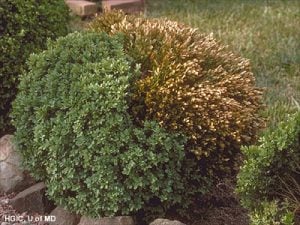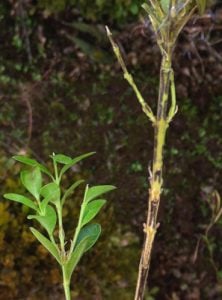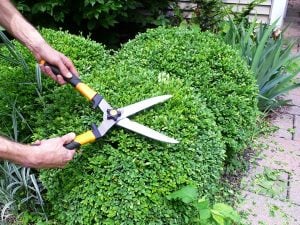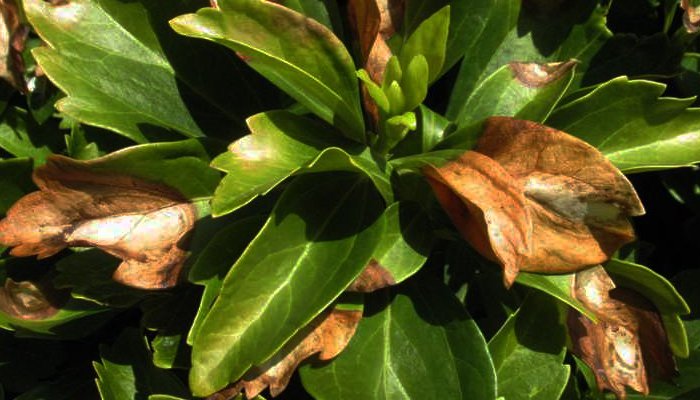Incorporating boxwood shrubs into landscape designs is extremely popular (especially in mid-upstate NY) for several reasons. Two of the most popular reasons are because they are great for privacy, and they are almost completely deer repellent. But, there are several diseases that affect boxwoods like Leafminer, Psyllid, Boxwood Blight, and Volutella Blight.
Volutella Blight is a newer boxwood disease caused by the fungus Volutella Buxi and can cause extensive losses. Japanese, Korean, English, and American boxwoods are susceptible to this disease. This pathogen enters through unhealthy or damaged plant tissue (winter injury or wounds). Younger leaves are much more susceptible to this disease than mature leaves. Optimal temperature for infection and disease to develop is 68-77 degrees F with relatively high humidity (around 85%).
If your Boxwood is experiencing stem cankers with girdling stems and overall dieback, this could be a sign it has contracted Volutella Blight. These symptoms become most apparent in early spring (generally in the form of delayed branch growth or an overall decrease in activity).
Other Visual Signs Of Volutella Blight:
-

Photo Sourced From https://extension.umd.edu Leaves on affected branches typically first turn green-yellow. They will then turn a red or bronze color before finally becoming a yellow/tan color.
- Dead leaves will typically turn upward but remain attached to branches. Leaves may eventually drop, but not always.
- The lower surface of affected leaves can develop fruiting structures on their lower surface that are pinkish in color. This commonly happens during periods of high humidity.
How Boxwood Blight Differs From Volutella Blight:
- Boxwood Blight causes severe, and quick, defoliation in the summer, especially during periods of rain or higher humidity. On the contrary, the symptoms of Volutella Blight will develop in early spring on the previous year’s growth, and before the new growth cycle begins.
-

Photo Sourced From https://pnwhandbooks.org Boxwood Blight comes with black streaks along the stems of the affected boxwoods.
- Boxwood Blight’s rapid defoliation differs from the leaf dieback of Volutella Blight. As mentioned earlier, dead leaves can remain on branches for extended periods of time with Volutella Blight, whereas, quick defoliation occurs with Boxwood Blight.
How is Volutella Blight Spread?
- Spores of the fungus that cause Volutella Blight are wet and sticky. Because of this, they only travel short distances. Volutella Blight is primarily spread by movement of infected plants, or contaminated gloves or other tools.
- Untreated water is also a big culprit of spreading the disease (flood water, runoff water, windy rain, etc.)
How To Manage Your Infected Boxwood:
-

Photo Sourced From Pinterest Make sure to prune your diseased boxwood at the proper time to avoid spreading. The branches and foliage should be dry.
- Sanitize pruning tools.
- Pruning improperly can lead to creating wounds, which makes spreading and/or worsening or the disease more likely.
- Thin the plants to promote better light and air circulation.
- Maintaining the health of your boxwood by watering properly is very important.
- Dispose of fallen/dead leaves and other infected plant parts.
- Prevent winter damage
- Apply fungicide to manage the disease (will not cure it)
Boxwoods are an extremely popular plant choice for homeowners and commercial properties because of their low maintenance qualities, their resistance to deer, and for use as privacy planting. However, it is important to understand that there are several diseases that can affect your boxwood. Properly caring for the boxwoods on your property and preventing weaknesses from forming is key in prevention. If you suspect your boxwoods may be infected with any of these common boxwood diseases, contact your tree care specialist to assist in putting the best care and management plan into place. Contact Red Cedar for your free consultation today!


